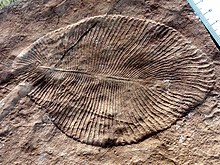
Back ديكينسونيا Arabic Dickinsonia Catalan Dickinsonia CEB Dickinsonia Czech Dickinsonia German Ντικινσόνια Greek Dickinsonia English Dickinsonia Spanish Dickinsonia Basque دیکینسونیا Persian
| Dickinsonia Temporal range: late Ediacaran, between
| |
|---|---|

| |
| Cast of Dickinsonia costata from Australia | |
| Scientific classification | |
| Domain: | Eukaryota |
| Kingdom: | Animalia |
| Clade: | Bilateria |
| Phylum: | †Proarticulata |
| Family: | †Dickinsoniidae |
| Genus: | †Dickinsonia Sprigg, 1947 |
| Species | |
|
See text | |
| Synonyms | |
| |
Dickinsonia is an early type of pre-Cambrian life. They were very different from current organisms. They are considered to be one of the early forms of multicellular organisms. Their bodies were shaped like discs. Based on the fossils, they were between four millimeteers an 1.4m in size.[2] They were only a few millimetres thick. Their body was segmented: there is a large central furrow, and smaller ones around the body of the organism. Their body was symmetric. Mostly based on the shape and size of the fossils found, they have been classified into different species.
The Dickinsonia species probably did not move around the ocean on their own: they used ocean currents to float around. Possibly they had a way to attach to the ocean floor. Their feeding probably resembled that of the placozoa.[3]
- ↑ Hofmann, Hans J. (1988). "An alternative interpretation of the Ediacaran (Precambrian) chondrophore Chondroplon Wade". Alcheringa. 12 (4): 315–318. doi:10.1080/03115518808619130.
- ↑ Retallack GJ (2007). "Growth, decay and burial compaction of Dickinsonia, an iconic Ediacaran fossil". Alcheringa: An Australasian Journal of Palaeontology. 31 (3): 215–240. doi:10.1080/03115510701484705. S2CID 17181699.
- ↑ Cite error: The named reference
Sperling EA & Vinther J (2010)was used but no text was provided for refs named (see the help page).